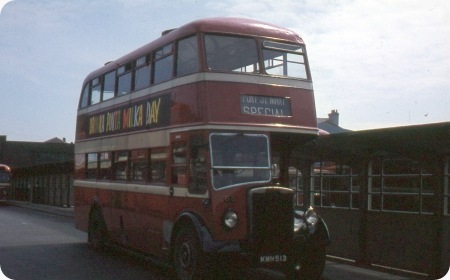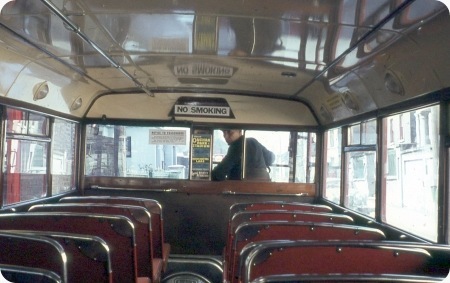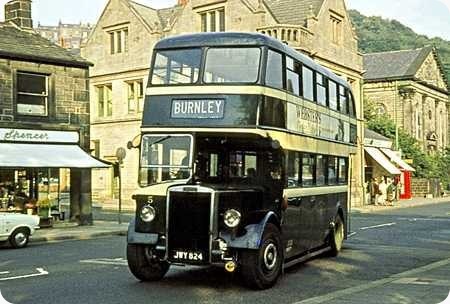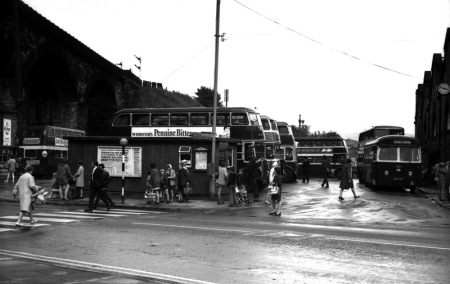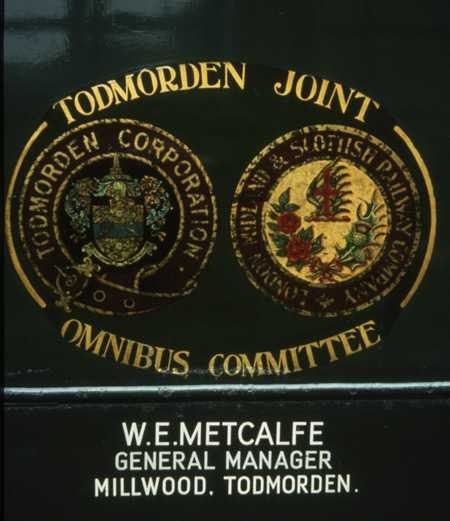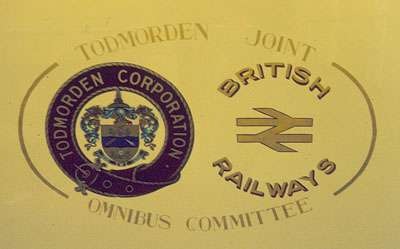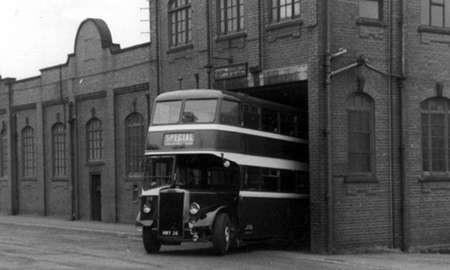Leeds City Transport – Leyland Titan PD2/1 – NNW 379 – 379
Leeds City Transport
1950
Leyland Titan PD2/1
Leyland H30/26R
This batch of sixty Leyland bodied Leyland Titans were delivered to Leeds in 1949-1950. Most of the batch were allocated to the Bramley depot for most of their careers providing most of the duties on the 54, 77 and 23 services as well as the Bramley contribution to the 11, 15 and 16 services. All were withdrawn in the late sixties. They along with the 1949-1950 AEC Regent IIIs were the last Leeds City Transport buses to carry via blinds as standard retaining them to the end of their careers. One 356 NNW 356 later ran for Saltburn Motor Services at Saltburn-by-the-Sea near Redcar. Seen here is 379 NNW 379 parked in the depot yard at the old Bramley depot which was originally a tram depot converting to buses in the early fifties.
Photograph and Copy contributed by Chris Hough
01/06/12 – 07:16
Great to see this view, Chris. Fond memories, as this was my "home" depot and these PD2s were the workhorses on my local 23, 54, 65 and 77 routes. Even when my family moved to Moortown in the early sixties, two of them followed me (377/378?) to operate Torre Road depot services to Moortown and Primley Park (69/70). Small point but, Bramley depot converted from trams in 1949. In those earlier days of "common sense" the friendly depot staff used to allow us lads to wander round the depot collecting numbers, even letting us sit in one of the PD1 cabs so we could pretend to drive it. The most dodgy thing we ever got up to was the occasional destination "twiddle" to try to show obsolete destinations like Guiseley.
Paul Haywood
01/06/12 – 07:17
These are the true "Farringtons" – the final, and definitive Leyland bodywork of 1951 – 1954 not strictly being so. Sheffield and Manchester had substantial numbers of Farringtons as well. They were only built on PD2/1 chassis and are distinctive with their separate sliders. [The ultimate "not Farringtons" were mostly PD2/12 and had ventilator sliders integrated into the window pans.]
David Oldfield
01/06/12 – 12:02
Thanks for the compliment Paul. As a lad I was also allowed in the depot often accompanying my dad when he went for his wages as he was a guard for LCT. To see the bus washer in action was the highlight of any visit! The two exits were both odd. The original tram exit was angled and narrow not a problem with a tram but a bus could easily suffer damage if the driver approached at the wrong angle. The "back door" was I think put in when the buses took over and had a steep ramp to ground level as the depot was on a hill The ramp wall is visible in the photo.
Chris Hough
02/06/12 – 07:15
Manchester’s Farringtons were on PD2/3 chassis. I’m pretty sure Southport’s were too. The same sliding window design then turned up with Duple, following the migration of an engineer from Leyland.
Peter Williamson
02/06/12 – 11:55
Leeds may have had the only PD2/1s with this style of body as they only bought 7ft 6ins wide buses apart from one batch of 8ft AECs until the advent of thirty foot long chassis. This was due to limited clearance between platforms in the bus station.
Chris Hough
07/06/12 – 10:34
Number 380 was transferred into the Driver training fleet after normal withdrawal, and I was given my job after taking my LCT application test in it one busy teatime in October 1969. It behaved like a dream and the true gentleman in charge of the School, Senior Inspector Albert Bradley, allowed me a few extra miles on top of the normal test route when I told him how much I was enjoying it – so instead of turning towards Town at the end of Old Lane we went up the Ring Road, through Middleton, and down Belle Isle Road. My only real criticism of these vehicles was the incessant rattling of the sliding windows which was really annoying to passengers. Also I’m sorry to say that many of the drivers NEVER used first gear – the bottom stop in Eastgate was the worst place, and some would nearly burn out the clutch when pulling away with a heavy load – the rattling windows had their own extra special "concerto" at this location !!
Chris Youhill
08/06/12 – 17:26
Back in 1949 whilst working on a neon sign for a well known Leeds grocery chain in York Road directly opposite Torre Road garage,(Long before the present road system was built including the M1 & M62) I witnessed the whole of this fleet in convoy heading towards the city centre…I have often wondered why, assuming these vehicles were Lancashire built, why were they entering the city from an easterly direction and not from the west. I assume that they would have had to take whatever route avoiding low bridges on their journey to Leeds. Also why did they by pass the main LCT garage? I would have thought this is where all new vehicles were vetted before being allocated to their respected depots….As a passenger I did travel regularly on these vehicles, and were super when flying up Burley Hill,and the internal body work was comparable to those "attractive" Roe bodies of the same era.
Interestingly though, two years later I was sent to Leyland’s Farington Foundry to sort out some electrical problem, and more concerned with the task in hand I didn’t show much interest of the activities that went on in this huge complex….but that’s another story.
Ken Greaves
Ken I can’t throw any light on the buses travelling from the east into Leeds. But I would hazard a guess that they were heading to the bus works on Donnisthorpe Street for checking prior to entering service. The wheel has now turned full circle in Leeds as Donnisthorpe Street in Hunslet is now the site of the First West Yorkshire head office The former had office in Swingate is now a Malmaison hotel.
Chris Hough
09/06/12 – 07:55
Great memories there Ken, and I may have been "on board" at the same time as you on many occasions as I lived at the top of Burley Hill in the early "70s." The PD2s were very spritely indeed, especially in the hands of drivers who correctly changed down into third, and occasionally second if heavily laden, with maximum engine revs so as not to lose momentum. Passengers in the habit of "baling out" at speed had to be very skilled and careful in those days if they were to avoid coming a cropper. In later half cab times, when I was driving the little AEC Mark V Regents on the same route but service 50 folks could step off easily half way up the hill as the anaemic asthmatic little blighters (the buses not the clients) were so gutless that Burley Hill had them licked. Coming the other way one morning peak up Kirkstall Hill towards the Merry Monk number 908 (1908 NW) – one of the final 8 foot wide batch – gave up the struggle and ground to a halt on the worst bend. This embarrassing predicament was partially explained by the inability of the conductress to manage even basic arithmetic – 60 plus 8 – the clients were standing almost everywhere apart from the roof, and there may have been one or two up there even but they will have slipped off due to the lack of hand grips !!
Chris Youhill
10/06/12 – 17:04
Yes Chris this part of York Road was more conducive to seeing Roe built vehicles travelling on it, after all the Roe factory was only just a couple of miles up the road at Crossgates. I wondered if this batch had been built at some other plant within the Leyland network but outside of Lancashire, or maybe held in some holding centre so delivery of the whole fleet could be made in bulk….We will probably never know.
During my five day stint at Farrington foundry, the official we (my apprentice and me) were to contact, was more insistent on giving us the grand tour of the place rather than giving us the lowdown on our reasons for being there…..However Farrington was not just another foundry, it assembled trucks and wagons of all shapes and sizes, including bus and trolley bus chassis. The trolley bus workshops were behind two large doors which were big enough to admit large vehicles such as a double decker bus unfortunately the doors were locked so we were unable to go in….The tour of the place finished at about three in the afternoon after which I was then taken to see the job I had come to do. I would have been over the moon if the grand tour had occurred after I had completed the job in hand instead of before…
Nevertheless it was grand experience for a 22year old…..But if trolleys buses were made at Farrington then coach building was done too! So could it be that the so called "Farrington" bus was so called for no other reason than it was made at Farrington as opposed to being made at some other plant within the Leyland framework, whatever design reference it might be.
Ken Greaves
11/06/12 – 08:37
Fascinating puzzle, Ken, regarding their eastern approach to Torre Road in 1949. Could the explanation be something as simple as them using the west/north Ring Road to avoid the congested Leeds city centre?
In 1949 I presume the route from Leyland would have been Blackburn, Burnley, Todmorden, Halifax and then possibly round the south of Bradford via Odsal and Stanningley (the Hebble route), or along the A58 to Wortley (on the YWD route). In this way, they could have then used (much of) the existing A6120 Ring Road around the west and north of the city as far as Seacroft, then eastward into Leeds along York Road to Torre Road. Pure speculation, of course, but assuming they were being driven by Leyland trade-plate drivers, perhaps the extra mileage was justified to avoid them being stuck in the centre of a strange city (full of trams, of course).
Paul Haywood
11/06/12 – 08:38
Chris Youhill, my in laws lived on the Sandford Estate and I lived at Hawksworth round the circus no doubt you will be very familiar with the No 50/51 route. Whilst I personally have no connections with the bus industry only as a passenger, I knew several people that did work on the buses. My brother was a conductor at Headingley during the sixties and seventies and two schoolmates who started as parcel boys worked their up to bus drivers George Kennedy was an upholsterer for LCT and George Brogden the keenest inspector of all, he was one of the drivers who drove the Leeds buses down to London during the war….. I also have lived in Little London (born there) Harehills, and Pontefract and back to Little London and now in the Carr Manors and are familiar with both trams and buses that operated in that particular area. I loved your tale of conking out on Kirkstall Hill god knows how many times this has happened whilst I have been a passenger on the number 50 bus, it always happened when an enthusiastic driver tries to change up a gear after crossing over Kirkstall Lane and then tries to engage first gear after the vehicle has ground to a halt. The thrill of this journey was the descent of Burley Hill after getting started again, to make up for lost time the driver would speed up (providing George Brogden the inspector wasn’t about) and one would wonder whether the brakes would hold or not, or would the bus topple over, it was certainly exciting….Most days the 50 bus and the 77 bus ran together and usually it became a race to see which bus reached the top or bottom of Burley Hill first. depending of course which direction the buses were travelling.
Ken Greaves
13/06/12 – 09:51
Ken, you paint a most evocative and accurate picture of the Leeds bus scene of fifty years ago. !! I may well have worked with your brother as I too was at Headingley from 1969 to 1986.
My own initiation into the 50 service has me blushing still – it was a Saturday afternoon in November 1969 and the bus was one of the aforementioned anaemic small Mark V Regents, and having persuaded it with difficulty while fully loaded to reach Hawksworth Circus I crossed the roundabout. I was pretty sure that the second right turn should then be taken, until I entered a narrow street where several worthies were washing their cars – foamy water and sponges flew everywhere as they ran for cover – I should have taken the first right turn !!
For the work shy element at Headingley and Bramley depots Morris Lane and Leeds & Bradford Road provided ample views to see over the Abbey fields what eastbound progress the opposition were making – this was the reason for much deliberate "bunching" of vehicles on the 50/77 between Kirkstall and Leeds. The poor old 23 was largely unable to participate in this contest as it was a very fast busy twenty eight minute run with only two minutes at each terminus.
When I came to a halt with 908 that morning I had remained in first gear all the way up from the Kirkstall Lane junction but still couldn’t prevent the lamentable and notorious thing from giving up, the last straw of course being the conductress’s record breaking load !!
Away from all this Brand’s Hatch and Le Mans nonsense I spent my last fourteen years (1987 – 01) at the Pontefract depot of South Yorkshire Road Transport (and successors) so once again may well have encountered you there. My best friend lives also now in the Carr Manors so once again "What a small world" eh ??
Chris Youhill
13/06/12 – 16:52
Chris Youhill…I lived at Pontefract from 1950 to 1953 and travelled each day to Leeds from Willow Park trying to avoid West Riding services whenever I could. South Yorkshire service was superb in every way,prompt warm fast clean cheerful, it was an almost personal service that you got. Those single decker Albions could certainly move. What a delight to board the Strachan bodied double decker on the return journey at night and fall asleep with your feet on the heater and not wake up until you had arrived back in Pontefract, after working all day in the frozen wastes of Ireland Wood and Cookridge on the new council housing estates.
Ken Greaves
14/06/12 – 07:42
You are right Ken about the superb service provided by South Yorkshire (Motors Ltd in that period). You may be surprised to hear that Albion/Roe double decker TWY 8 (which was still a single decker coach in 1950/3) is now in advanced preservation and appears at rallies. When I started work with the Firm in 1987 I was just astounded to find that the Atlantean, Fleetline and Olympian double deckers were fitted by the Company with water squirters on each driving mirror, allowing clear vision in the worst of weather on muddy roads.
Chris Youhill
14/06/12 – 07:45
Chris Y – I really think you should write a book of your experiences in the bus industry of yesteryear – all good stuff and generating a chuckle or two: maybe not for you at the time, however!
Chris Hebbron
14/06/2012 14:17:46
Couldn’t agree more with Chris H about Chris Y.
David Oldfield
14/06/12 – 14:18
Chris Hebbron…I totally agree, Chris Y should write a book, then we could all contribute something.
Ken Greaves
14/06/12 – 14:19
Chris Y- was there a video of TWY 8 here on Bus Sounds running up Dewsbury cutting on a running day presumably….?, but it was taken down from You-tube… anyone know where it is?
In the old mining areas ample water was essential on all glass, as you collected a film of grey/black greasy slurry off the roads. My first Morris Minor initially had no screenwasher- frightening. Good on them!
Joe
15/06/12 – 05:51
Thanks to Chris H, David and Ken for that literary vote of confidence – I should have written such a book years ago and would still love to do so, but am now very "senior" for that sort of venture.
Off to Norfolk now with two friends to sample the preserved railways – no doubt drenched if the forecasters are correct – but will catch up with everything on Monday hopefully.
Chris Youhill
15/06/12 – 12:19
How about someone getting you a digital recorder for you to speak your recollections into, Chris? That way you don’t have to tax the senior brain but just chat, as to a friend – rather as you do here in cyber-space.
David Oldfield
01/07/12 – 10:31
Just stumbled across the photo of the LCT PD2 379 at the old Bramley Town End Depot and spent the last 30 minutes enthralled by the comments of Chris Youhill et al. These NNW’s plus the XUM small Regent V’s with their well proportioned exposed radiator 7ft 6ins Roe bodies represented my very early introduction to the industry, a precursor to a life long career, thankfully still continuing over 45 years later !
Although born in Nottinghamshire, my Grandparents lived on Kirkstall Hill in Leeds and from an early age various weekends and school holidays would be spent sat at a bedroom window watching the 23’s, 50’s and 77’s travelling up and down the hill. Long before awareness of BBF Books (Yorkshire Municipal Edition) or Busses Illustrated I had worked out that regular performers on the 23/77’s were PD2’s 350-399 and the Regents 863-894 with allocation split between Bramley and Headingley Depots. Trips into Leeds with Grandma always offered a choice to/from Eastgate with the AEC’s winning the day (perhaps it was the struggle up Burley Hill with the throaty but underpowered 470). This would have been the period 1963-1968 when my family moved to Burley in Wharfedale but what memories! Even before that time, the old NNW’s were being replaced with newer versions (1953 built 301-310 and 1955 201-220 and even further XUM’s from the batch 840-862) so for me, the end of an era and happy childhood memories bus watching. I do remember that four of the NNW’s (394, 396, 397, 398) remained for sometime after the rest had disappeared, I believe to the end of 1968 and of course as mentioned by your other contributors 380 found itself on Driver Training Duties.
Move forward 30 years as Operations Manager at Bramley Garage (what coincidence!) and responsibility for those same Kirkstall Hill services, although the 23 long consigned to history, the 77 now the 49 to and from Bramley Garage but still the 50, the latter routes now operated by Olympian Royales. Plenty more memories, although on occasion the memory may play tricks and I thank you for helping jog them. I will be happy to share on line if of value.
Keith Roebuck
02/07/12 – 07:23
I’m sure we’d like to hear of your experiences in the industry, humorous or otherwise, Keith – they can always be posted under "Articles"
Chris Hebbron
07/07/15 – 06:33
I lived in Newcastle from 1961-66. During that time PD2 NNW 345 appeared regularly outside Newgate House, where I worked, running for a local operator.
Colin Milner
17/07/15 – 12:39
I can remember going to School by Leeds City Transport on routes 50.51&77 which went via Burley Hill Leeds and were operated by Leyland Buses with a Charles Roe body I think they were classed as PD1 and had a crash gearbox and always had to stop on the hill to select the appropriate lower gear. before moving to Leeds I lived at Yeadon and travelled on Samuel Ledgard buses which ran between Otley & Horsforth via Yeadon they were Bedfords with wooden plank seats and there registration numbers were JNW 347&348, I would like to see a photograph of one of these if.possible.
Howard Clayton
17/07/15 – 12:42
I’m afraid our expert on Samuel Ledgard has been taken poorly a couple of days ago, but he will be back with us shortly.
Peter
18/07/15 – 06:18
Colin M, the Newcastle operator of whome you speak was Armstrong of Westerhope. They ran a service from Newcastle to Stanfordham. The Newcastle terminus was outside what was the Co-op department store in Newgate Street. When T&W PTE were created, the route came under their control, and Armstongs, along with Galleys coaches became Armstrong Galley, the coaching division of T&W PTE
Ronnie Hoye
25/07/16 – 09:48
Seemingly forgotten in this talk of the Bramley vehicles is the operation of the PD2/1s on the 38 Moortown-Whitkirk from about the time of their entry into Leeds service throughout most of the 1950s. Where were these buses stationed? Torre Road presumably but does anyone know for sure?
David A. Young
25/07/16 – 15:11
No trouble David in confirming that the 38 route was operated by Torre Road depot – two buses were required to maintain the half hourly frequency, a round trip being one hour. Crew (later OPO) changes took place at the Melbourne roundabout, the staff using other bus services to and from.
Chris Youhill
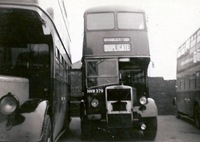 Vehicle reminder shot for this posting
Vehicle reminder shot for this posting
17/01/17 – 15:15
Depends what period Howard Clayton (17/07/15 – 12:39) is talking about. I don’t ever remember PD1s doing the 77 route, certainly not during my time at Bramley garage (late ’58’to end of ’59) – the PD1s were always on the 46. The PD2s had a crash 1st gear and synchro on 2nd 3rd &4th. 1st would be engaged to pull away after stopping at the bus stop after turning right off Kirkstall Hill, where the 77 then joined the same route as 50/51 (Daimlers from Headingley Depot). Were these Daimlers Charles Roe war time utility bodies, I’m not sure?
On the opposite corner to the bus stop, in that small parade of shops, was a fish & chip shop owned by Albert Hardisty – his brother was Inspector Cyril Hardisty!, who twice caught me not wearing my hat – a hanging offence. Albert was my wife’s uncle- small world, eh?
Richard Watson
Quick links to the - Comments Page - Contact Page - Home Page

